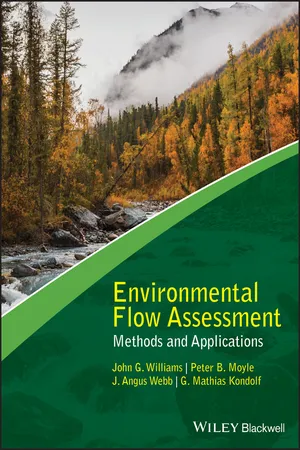
Environmental Flow Assessment
Methods and Applications
- English
- ePUB (mobile friendly)
- Available on iOS & Android
Environmental Flow Assessment
Methods and Applications
About this book
Provides critiques of current practices for environmental flow assessment and shows how they can be improved, using case studies.
In Environmental Flow Assessment: Methods and Applications, four leading experts critique methods used to manage flows in regulated streams and rivers to balance environmental (instream) and out-of-stream uses of water. Intended for managers as well as practitioners, the book dissects the shortcomings of commonly used approaches, and offers practical advice for selecting and implementing better ones.
The authors argue that methods for environmental flow assessment (EFA) can be defensible as well as practicable only if they squarely address uncertainty, and provide guidance for doing so. Introductory chapters describe the scientific and social reasons that EFA is hard, and provide a brief history. Because management of regulated streams starts with understanding freshwater ecosystems, Environmental Flow Assessment: Methods and Application s includes chapters on flow and organisms in streams. The following chapters assess standard and emerging methods, how they should be tested, and how they should (or should not) be applied. The book concludes with practical recommendations for implementing environmental flow assessment.
- Describes historical and recent trends in environmental flow assessment
- Directly addresses practical difficulties with applying a scientifically informed approach in contentious circumstances
- Serves as an effective introduction to the relevant literature, with many references to articles in related scientific fields
- Pays close attention to statistical issues such as sampling, estimation of statistical uncertainty, and model selection
- Includes recommendations for methods and approaches
- Examines how methods have been tested in the past and shows how they should be tested today and in the future
Environmental Flow Assessment: Methods and Applications is an excellent book for biologists and specialists in allied fields such as engineering, ecology, fluvial geomorphology, environmental planning, landscape architecture, along with river managers and decision makers.
Frequently asked questions
- Essential is ideal for learners and professionals who enjoy exploring a wide range of subjects. Access the Essential Library with 800,000+ trusted titles and best-sellers across business, personal growth, and the humanities. Includes unlimited reading time and Standard Read Aloud voice.
- Complete: Perfect for advanced learners and researchers needing full, unrestricted access. Unlock 1.4M+ books across hundreds of subjects, including academic and specialized titles. The Complete Plan also includes advanced features like Premium Read Aloud and Research Assistant.
Please note we cannot support devices running on iOS 13 and Android 7 or earlier. Learn more about using the app.
Information
CHAPTER 1
An introduction to environmental flows
Summary
1.1 What are environmental flows?
- Whether to reserve some portion of the flow in a stream for environmental uses, and if so, how much, and on what kind of schedule;
- How effects of an existing project on streams or estuaries can be mitigated (or not) by releases of environmental flows or restrictions on water withdrawals;
- Whether and how to modify existing water projects to improve environmental conditions;
- Whether and how to build a new water project.
1.2 Why EFA is so hard; scientific issues
1.2.1 Stream ecosystems are dynamic and open
Box 1.1 Variable Effects of High Flows on a River Ecosystem
The stability and sustainability of Bristol Bay sockeye salmon have been greatly influenced by different populations performing well at different times during the last century. Indeed, no one associated with the fishery in the 1950s and 1960s could have imagined that Egegik would produce over 20 million fish in 1 year, nor could they imagine that the Nushagak would produce more than the Kvichak, as it has in the last 4 years. It appears that the resilience of Bristol Bay sockeye is due in large part to the maintenance of all of the diverse life history strategies and geographic locations that comprise the stock. At different times, different geographic regions and different life history strategies have been the major producers. If managers in earlier times had decided to focus management on the most productive runs at the time and had neglected the less productive runs, the biocomplexity that later proved important could have been lost.
1.2.2 Fish evolve
Table of contents
- Cover
- Table of Contents
- About the authors
- Series foreword
- Preface
- Acknowledgements
- CHAPTER 1: An introduction to environmental flows
- CHAPTER 2: A brief history of environmental flow assessments
- CHAPTER 3: A primer on flow in rivers and streams
- CHAPTER 4: Life in and around streams
- CHAPTER 5: Tools for environmental flow assessment
- CHAPTER 6: Environmental flow methods
- CHAPTER 7: Good modeling practice for EFA
- CHAPTER 8: Dams and channel morphology
- CHAPTER 9: Improving the use of existing evidence and expert opinion in environmental flow assessments
- CHAPTER 10: Summary conclusions and recommendations
- Literature cited
- Index
- End User License Agreement